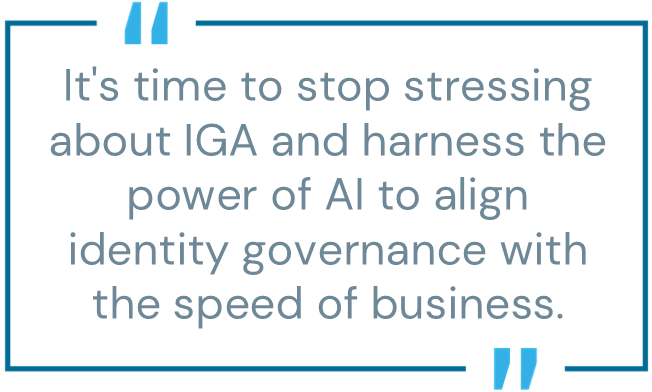The future of identity governance: fast, secure, and scalable

If the mere mention of identity governance and administration (IGA) stresses you out, you’re in good company.
Managing digital identities and access privileges is a significant challenge that only grows more difficult as cloud adoption accelerates, and environments and threats become increasingly complex. Today, many organizations struggle to support the three key IGA business drivers: compliance, lifecycle management, and security. Recent insights from a survey of CISOs underscore their top pain points:
1. User access reviews (UARs) are resource-intensive and fraught with compliance challenges
Access reviews are a growing compliance requirement for nearly every organization. Anyone involved in the process knows how laborious and time-consuming it can be to compile, examine, and validate the massive troves of entitlement data to the satisfaction of auditors—ensuring permissions, for both human and machine users, are justified and not excessive. The task doesn’t fall to a single team—compliance managers, application and data owners, and people managers all expend considerable effort to prepare and complete even a single UAR under one regulatory requirement.
The challenge is only amplified by the breadth of compliance coverage demanded: 80% of CISOs report they must meet two or more UAR-related regulations, and over half (55%) are on the hook for five or more. Most see no relief ahead; 84% expect compliance obligations to become even more extensive in the next three years.
2. Provisioning users remains a slow, manual process
Effective lifecycle management—ensuring users receive the right entitlements when they join, move within, or leave an organization—is essential, but rarely quick or straightforward. Employees and contractors are often left waiting for the access needed to start their work, with our survey revealing that 55% of organizations average more than seven days for provisioning. This means that every employee or contractor loses a week (or more) of productivity while waiting to jump into their new roles.
This wait is a serious frustration for business managers who need teams to be operational without delay. Conversely, attempts to fast-track provisioning sometimes result in over-provisioned users, inadvertently introducing new security risks.
3. One in seven access entitlements is inappropriate
From excessive privileges to dormant or rogue accounts, risky access frequently persists for months, exposing organizations to avoidable identity-based threats. On average, organizations need to revoke 13.7% of all enterprise-wide entitlements as they’re deemed to be inappropriate during user access reviews. In other words, the rapid pace of business change causes one in seven entitlements to be excessive.
In midsize and large enterprises, this can mean needing to revoke thousands or even tens of thousands of application or infrastructure entitlements sprawled across the enterprise every quarter—a herculean effort on its own.
Why is identity governance so difficult?
Despite these challenges, many organizations still use decades-old IGA systems designed primarily for on-premises environments. Meanwhile, they rely heavily on cloud services and hundreds of new SaaS applications (with millions of entitlements) to drive their businesses forward. This creates a perfect storm for identity headaches and risks:
1. 82% of organizations struggle with application onboarding
The value of an IGA deployment is proportional to the number of applications onboarded into a deployment. For example, if an application isn’t onboarded, IGA lifecycle management can’t deliver provisioning or de-provisioning to that app. Unfortunately, legacy IGA solutions are notoriously slow and cumbersome when onboarding new applications –they just can’t keep up with the pace of the business and cloud-scale demands.
2. 84% rely primarily on manual processes for user access reviews and provisioning
IGA processes involve hundreds or even thousands of stakeholders across an enterprise. When these stakeholders get bogged down with manual tasks—such as requesting, approving, implementing, reviewing, or revoking entitlements—business processes become slow, burdensome, and costly.
Today, only 6% of organizations report having fully automated IGA processes, which means there’s lots of room for improvement.
3. Only 10% of organizations are successful in defining and maintaining a useful set of roles
In most organizations, role-based access control (RBAC) is a mess. It’s well understood that roles can significantly simplify governance processes. However, defining roles—particularly business or functional roles across multiple applications—isn’t easy. And centralized roles teams typically don’t have the context to do this well.
Today, cloud adoption is making the computing environment increasingly decentralized; application owners and administrators and business data owners have much of the context about who can and should use their apps and data. Even when a centralized roles team pulls the context together to define good roles, finding role owners to maintain them is a chore.

Transforming IGA with automation
What worked for IGA 20 years ago clearly isn’t working today. As enterprises navigate the proliferation of privilege in complex identity landscapes, modern IGA capabilities become critical for protecting digital assets and maintaining business agility.
At the heart of this shift is automation: automation to streamline application integration, transform IGA business processes, and simplify role definition and maintenance.
To bring this to life, let’s break down the work involved in the user access review process and how automation can transform each step to reduce human effort by up to 80%.
Step 1: Campaign preparation
The UAR process starts with pulling entitlement data for a campaign together by collecting entitlements from all relevant systems, correlating the entitlements to user identities gathered from HR applications and user directories, and then preparing a campaign based on individual reviews targeted at supervisors and app owners.
Automation doesn’t just streamline the app integration process dramatically; it also simplifies campaign prep by ensuring app data is clean with up-to-date descriptions so reviewers can easily understand what they are reviewing.
Step 2: Reviews
Reviews are often repetitive and painful. AI-driven automation can reduce the size of a review by establishing pre-approved access prior to a review, thus shrinking the review items list substantially and improving each reviewer’s user experience.
Step 3: Revocations
Automating revocations and providing closed-loop tracking significantly slashes the time and effort needed to provide proof of compliance.
Step 4: Audit readiness
Finally, automation takes audit readiness to the next level by pre-packaging evidence for auditors. Instead of saddling campaign managers with the burden of satisfying auditors or expecting auditors to troll the IGA system, packaged evidence files are created to satisfy auditor requirements around UAR completeness and accuracy.
Similarly, automating the slow, highly complex provisioning process can help organizations accelerate onboarding with 60% fewer tickets while reducing risky, excessive entitlements by 20% on average. And role definition and maintenance can be replaced by AI that manages pre-approved access and simplifies joiner and mover processes.
This new AI and automation focused approach has proven very successful in the market. It delivers fast time-to-value and enables IGA deployments to scale quickly to hundreds of applications.
Achieving seamless identity governance: The final piece
Today, almost half (49%) of organizations lack full visibility into entitlements and permissions across their entire cloud environment, according to the CyberArk 2025 Identity Security Landscape. Where identity controls do exist, they’re unevenly applied—fewer than 40% report coverage for cloud infrastructure and workloads. Controls drop further for DevOps environments (35%), AI and LLMs (32%) and service accounts (23%)—despite these being some of the fastest-growing areas of risk.
Given this inconsistent oversight across increasingly complex ecosystems, 32% of organizations plan to invest in identity governance and compliance (IGA) this year. Modernizing with a faster, more adaptive IGA solution will be critical for improving overall visibility and making governance easy, intuitive, and all-inclusive.
Of course, modern IGA is just one essential piece of a comprehensive identity security strategy. Working in tandem with identity and access management (IAM) and privileged access management (PAM), IGA helps to ensure compliance, supports least privilege access, and aligns with Zero Trust principles. IGA also reduces manual effort, improves productivity, and helps organizations meet regulatory demands without burning out security teams in the process.
It’s time to stop stressing about IGA and harness the power of AI to align identity governance with the speed of business.
Deepak Taneja is co-founder of Zilla Security and GM of Identity Governance at CyberArk.
🎧 Ready to scale smarter? Tune into Deepak Taneja’s appearance on the Security Matters podcast—“A new identity crisis: governance in the AI age”—where he explores how AI is transforming identity governance and what it means for security teams navigating today’s complex digital landscape.